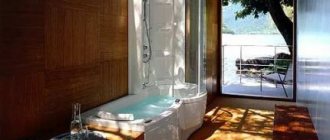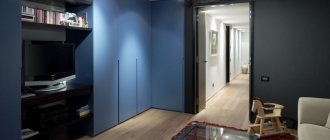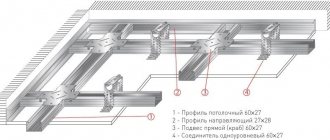Chandeliers are the main element of lighting in various interiors. The kitchen is no exception, although the microclimate here is quite difficult. Designers now often abandon these devices in favor of spotlights and spots, diode strips, and luminous ceilings. But there are still many lovers of the classics, and this will always be the case. The article provides detailed information on how to choose a chandelier for the kitchen depending on size, design, ceiling height and other parameters.
Criteria for choosing a chandelier for the kitchen
High humidity, soot, heat - these are the conditions in this part of the housing. Therefore, lighting fixtures here must meet certain requirements. So, in the kitchen it is better to use lamps and fixtures with protection from dust and moisture with an index of at least IP44.
Model and type of fastening
The following types of chandeliers are distinguished by design:
- Suspended - the lamp is suspended from the ceiling on a cord, chain or stay. Such models are suitable only for a room with a ceiling height of more than 2.5 m. As a rule, a hook is used as a fastening; the wires are hidden under the decorative glass of the lighting fixture. In some products it is possible to adjust the height of the suspension. More often, vertical varieties of chandeliers are used, with shades located on the same line. The growing popularity is due to the fact that the flow of light is more uniform compared to horizontal design.
- Ceiling - devices are attached directly to the concrete floor. They take up less space, so they are more suitable for rooms with low ceilings and are successfully used even in squat rooms of standard panel high-rise buildings. Ceiling chandeliers are mounted on a straight or cross-shaped bar, the wiring is hidden in the device body. The inconvenience of some models is that they have to be partially disassembled to replace the light bulb.
The material from which the device is made is also of enormous importance. After all, in the kitchen the chandelier will have to be washed from soot, even if there is a hood installed above the stove. There is no ideal solution here, but the most convenient to care for are:
- Plastic . Lightweight material, easy to clean and suitable for kitchen conditions. But often plastic fades from the sun, becomes brittle and can break if handled carelessly.
- Metal . Only products coated with powder paint, mastic or other means that protect the surface from corrosion are suitable.
- Glass and crystal . The lampshades are easy to clean and do not react with household chemicals. However, crystal chandeliers are usually made of small parts, and cleaning each one will take a lot of time.
- Wood . Such products are afraid of moisture and temperature changes. Therefore, the surface must be covered with protective compounds - varnish, paint or wax, then you can opt for a wooden model. But there is one more inconvenience: wood absorbs odors. Rattan and matting have similar properties.
Read more: What types of chandeliers are there?
Chandeliers with lampshades made of paper and textiles are absolutely not suitable for the kitchen. They quickly become dirty and cannot be cleaned of soot and grease stains. Even the most powerful ventilation does not solve the problem.
The color should not be easily soiled. You should not choose devices with ornate and complex elements. Washing them is long and inconvenient. It is best to pay attention to the simplest forms.
Chandelier size
Large lighting fixtures look bulky and visually “compress” the space; a cramped room with them seems even smaller. Therefore, the lower the ceilings, the flatter the chandelier you need to choose. And the more compact the area, the smaller the lampshades should be.
The height of the device is determined by dividing the footage from floor to ceiling by 4. But you need to take into account that the distance from the bottom point of the chandelier to the floor must be at least 2 meters, so as not to hit the light bulbs with your head.
The exception is lamps above the dining table. People will not walk here, so the lighting fixture can be lowered lower.
The diameter of the chandelier is calculated using the formula: the width of the room plus the length divided by 10. For example, for a 3x4 m kitchen you need a device with a diameter of 70 cm. However, this calculation is more suitable for square or similar rooms.
Kitchen features
When choosing a chandelier, the shape of the room is taken into account. It can be large, small, elongated, low or tall. The choice of model and location of the lighting fixture depends on this. For example, if you hang a chandelier in the center in a long, narrow kitchen, you will get darker areas in the corners and the level of illumination will be insufficient. The optimal solution in this case would be to use paired companion chandeliers. We will consider this issue in more detail below and give recommendations for each room.
Required degree of illumination
The light from the chandelier should be moderate so as not to blind the eyes, but at the same time bright enough for safe work with cutting tools. For every 10 m², the required norm is the use of light bulbs of the following power:
- incandescent lamps - 120 W;
- halogen - 60 W;
- fluorescent (energy saving) - 30 W;
- light-emitting diode (LED) - 15-20 W.
You can use one or more lighting elements, which together will provide the required power.
A lamp with a light intensity regulator is extremely convenient in the kitchen. It allows you to select the optimal mode depending on the situation, time of day and weather. Another valuable accessory is the remote control, which makes operating the chandelier more convenient, especially in combined kitchen studios.
Interior style
When choosing a model, they also take into account the design style. So, for modern trends, modern, loft, and spider chandeliers are most suitable.
In such a kitchen, both creative design models and laconic and stylish geometry are quite appropriate.
Modern interior is comfort, original furniture. Lampshades in the form of a ball, rhombus, or triangle look beautiful here.
A classic interior is associated with candelabra chandeliers and crystal. But they are quite bulky, so they are installed only in large kitchens, mainly above the dining table.
In Khrushchev such models are superfluous. A large lighting fixture will clutter up the space and visually reduce the height of the ceiling. This option is suitable exclusively for spacious rooms.
For a classic interior of a small area, you can purchase lamps with images or details in the form of flowers.
Floristry also fits well into Provence, shabby chic, and country styles. Flowers perfectly emphasize and complement these directions.
A rustic or hunting lodge will be decorated with a lamp with candle bulbs, metal or wooden parts.
Forged products, imitation of an aged surface like bronze or silver will fit perfectly into this style.
Ethnic lamps are a separate topic, since Japanese, British, African, and oriental styles are distinguished here.
For example, a kitchen in the style of the Land of the Rising Sun requires the use of wooden chandeliers, and Moroccan lamps will complement Arabic interiors.
Laconic Art Nouveau lampshades fit perfectly into high-tech and minimalism. Chandeliers in avant-garde and vintage styles are also chosen here. But products made of plastic, glass, metal, in strict geometric shapes and with a clear, no-frills silhouette are more suitable than others.
Interior design in Provence style is a modest French romance, gentle and sophisticated.
Retro lamps with floral prints and wood details in neutral shades are installed in such a kitchen.
For eco-style, models made from environmentally friendly materials are more suitable than others. These are rattan, driftwood, dry branches. Often lighting fixtures are made by hand. Such chandeliers become interior decoration.
Models reminiscent of street and industrial lamps are selected for the loft. Some of them are quite compact and suitable even for low ceilings.
They are distinguished by rough execution, dominance of metal, aged surfaces, and often the absence of shades. But you can also install classic designs of simple design, lamps made of copper, bronze and other metals, with the exception of gold.
A special approach when planning the interior must be taken if you want to hang a Tiffany chandelier.
It is notable for its stained glass lampshades, which always look like a bright spot in space and massive. Therefore, the remaining finishing elements are selected to match it, and not vice versa. Stained glass chandeliers look most impressive in spacious kitchens.
But all the recommendations described are not an axiom. You can successfully fit a crystal chandelier into a loft, light bulbs without shades into a country style, etc.
Such contrast enlivens the space and adds its own flavor. Different styles look best in spacious rooms. But moderation is important here. You should not combine more than three directions in one interior. But in cramped kitchens it is better to be more restrained in your dreams.
But no matter what style you choose, the color of the chandelier should match the decoration. Designers do not consider it possible to use more than three colors in a room, and the lamp must repeat one of them.
The lampshade can match the kitchen unit, floor, wallpaper or some interior items. Only transparent lampshades are universal, they seem to dissolve in the room. They look great even with bright trim. It is much more difficult to fit catchy models into the interior; when decorating, you will have to build on them.
Light and style
Today, the following kitchen design styles are considered the most relevant:
- Provence;
- Modern;
- Country;
- Fusion;
- Chalet.
The lighting of a kitchen decorated in Provence style should be bright. The main thing is lighting the dining area. Additional lighting is placed so that it is as invisible as possible.
- The central lighting element in the Art Nouveau style is a massive lighting fixture with an intricate shape.
- In country style, designers recommend using vintage forged chandeliers, pendant lamps in the form of lanterns or candlesticks.
- Fusion requires a combination of seemingly mutually exclusive decorative elements. Therefore, a kitchen set made of expensive wood can be illuminated with appliances made of plastic.
- In chalet style, everything should look bulky. Forged lamps, devices with decor made of wood or deer antlers are quite appropriate here.
Where is the best place to place a chandelier?
The main light source is always located in the middle of the ceiling. But this rule only applies to a small kitchen. Spacious rooms are usually divided into dining and working areas, and one chandelier is not enough here.
A rectangular and oval table is illuminated with two or three small companion chandeliers at once. They do not have to be absolutely identical, and may differ, for example, in the color of the lampshade. With this lighting, all diners will feel equally comfortable.
Paired devices are also used in another way: one is hung above the table, the second above the bar counter. A fashionable element of a modern kitchen is an island or peninsula. The chandelier can be placed directly above them. Chandelier fans will also come in handy here.
In the dining room, the lighting fixture should be placed no closer than 70 cm to the surface of the tabletop, otherwise the light bulbs will blind the eyes. For the second part, local lighting is used - built-in or overhead spotlights.
Work zone
The place in which food is prepared should be illuminated as brightly as possible.
Devices used to illuminate the work area must be resistant to moisture and elevated temperatures. Ease of maintenance is also an important requirement. If the apartment has a studio layout and has a bar counter, this must be taken into account when designing the lighting.
It is necessary to use bar lights for kitchens, through which the counter will be illuminated. This will ensure ease of work in the kitchen and will further delineate the kitchen and living areas.
A separate lighting fixture should be placed above the workplace. This can be a fairly large fluorescent lamp or spotlights integrated into the ceiling.
How to choose office LED lamps - see the instructions here! Photos of ready-made solutions + electrician’s answers- Choosing the best linear LED lamps: types, installation rules and tips for choosing LED lamps (130 photos)
- Vertical blinds: features of the mechanism, pros and cons, photos of beautiful design
You can also use wall lights located above the kitchen splashback or under the cabinets.
Lamps for kitchen furniture will also help illuminate the work area. They are usually mounted underneath wall cabinets. Installation can be carried out overhead or by direct integration into cabinets.
How to choose a chandelier for a non-standard room
The choice of chandelier largely depends on the configuration of the room. The biggest problem we have to face is the small area. Transparent lampshades that seem to dissolve in air will not steal space.
Designers recommend minimalist chandeliers for small kitchens. Even with large sizes, they look neat and compact, do not clutter up the space, and fit into many interior variations.
In the work area, be sure to use lighting under wall cabinets or on the ceiling in the form of spot spots or LED strips. One lamp above the dining table or several neat pendants would also be appropriate here. They should be compact, but not small. In the latter case, the shortcoming will only be emphasized.
There are other problems that affect the choice of lighting fixture:
- Low ceiling . This requires chandeliers with horns facing the top. The lower they are located, the flatter the lampshades should be.
- Narrow elongated rooms . For uniform illumination, you need pendant fixtures with oval or rectangular shades, with lamps at the same level to equally illuminate the entire kitchen area. Proper lighting can also be created with the help of companion chandeliers located closer to narrow walls.
- The rooms are too big . This is also a drawback that makes it difficult to choose lighting. This requires massive hanging chandeliers with numerous arms. An abundance of details will fill the empty space. Additionally, they can be combined with spotlights.
- High ceilings . This kitchen looks uncomfortable. Multi-level models will add comfort, visually reducing the distance to the floor.
Types of lighting in the kitchen and their options
First of all, let's divide the kitchen into separate zones. Each of these zones requires different lighting, which means the lamps must be different.
General lighting
General kitchen lighting
One of the most important for the kitchen, as well as for any other room, is general lighting. On some sites it is also called the top one, although this is not entirely correct.
It should provide enough light to move around the room, as well as to perform simple operations. This type of lighting is strictly standardized by such a regulatory document as SNiP.
General kitchen lighting options
- According to this document, general lighting in the kitchen should be at least 150 lux. In general, this is not very much, if you do not take into account the fact that this is the minimum acceptable value. Less is not possible, but more please. Typically, lighting for the kitchen is about 300 Lux. This is quite enough to make the room feel brightly illuminated.
Luminous flux of various lamps
- We have already discussed how to calculate the illumination of a room more than once in our previous articles, so we will not return to this issue again. But if you are not familiar with the simplest calculation methods, then do not be alarmed, there is nothing complicated about it. Even a schoolchild who does not have special knowledge can do this.
Kitchen lighting uniformity
- In addition to the quantitative parameter for general lighting, qualitative indicators are also standardized. We'll talk about them a little later. Now let's focus on uniformity. For general lighting in the kitchen, it is extremely important that the lighting is uniform.
- To achieve these goals, lamps must have a good diffuser. This is especially true for rooms with spot lighting. At the same time, to achieve maximum effect, it is better to use lamps of small unit power, but a lot.
Note! When using a large number of lamps, they should not be placed in one place. They should be located as evenly as possible around the entire perimeter of the room. Special layout diagrams have even been developed for this, which you can see in the photo below.
Uniform placement of spotlights is very important
- General lighting must take into account the location of the furniture. After all, it can obscure part of the room, which will negate all our efforts. This is especially important if you plan to move furniture in the kitchen.
Creating general lighting using directional lamps
- In such cases, you need to either think through all possible options in advance, or use a lighting system with the ability to change the location of the lamps. Fortunately, there are currently track systems that can do this. Yes, their price is still steep, but in some cases this is the only possible option.
General lighting must take into account the location of the furniture
- When creating general lighting, try to avoid installing sconces and other wall-mounted lighting fixtures. The fact is that they create a lot of shadows, which makes it very difficult to create high-quality side lighting without a professional approach.
Work area lighting
The second most important thing is the lighting of the kitchen work area. This parameter is also controlled by SNiP and is already 300 lux.
The placement of luminaires is very important, especially in the work area
- But here we immediately draw your attention to the fact that this is the minimum acceptable parameter. To create good illumination of the work area, we will need no less than 500 lux. Some will say that this is overkill, but in the kitchen work area the lighting should be of very high quality. Therefore, increased demands are placed on him.
Uniform lighting of the kitchen work area
- First of all, this concerns the uniformity of lighting. After all, sudden changes in light zones cause eye fatigue. And in such a small space as a work area, such differences will be especially obvious.
Linear luminaires for illuminating the work area
- Therefore, here, again, you should use the maximum number of not too bright lamps. Linear LED kitchen lights that are able to provide proper uniformity of lighting are a good choice.
Linear lamps installed in a furniture niche
- They can be installed both at the top of the apron and at the bottom of hanging cabinets. But installing such lamps in the lower part of the apron or in its central part is fraught with consequences such as glare. Indeed, in this case, direct light will hit you directly in the eyes, which is far from the best option.
Lamps built into the bottom of hanging cabinets
- Sometimes an LED kitchen lamp is built directly into the bottom of hanging cabinets. But this comes with a number of technical difficulties. Firstly, it is necessary to close the contacts of the lamp. To do this, use either a special plate or a double bottom. Secondly, this is the need to connect the wires. Again, you need a second bottom or a metal corrugation to hide the wires.
- Yes, you may come across the opinion that, well, there are wires lying on the bottom cabinet of the furniture, and the lamp is not closed, well, there’s nothing to worry about. But this is only until you accidentally damage the wire or flood it with water. But when a fire breaks out, then you will regret this decision three times - it violates the rules of the PUE, which prohibit the direct laying of wires on combustible structures.
Glowing kitchen apron
- Another interesting option is to use luminous aprons, as in the video. When installing glass as an apron, it is quite possible to mount an LED strip under it, or simply install lamps. As a result, the entire surface of the apron will emit light.
Glowing glass apron
- But there are also certain difficulties here. They are due to the fact that such a surface looks beautiful only if the entire surface is illuminated evenly. This can be achieved either by increasing the number of lamps, or by increasing the distance from the lamps to the glass. And the surface of the glass itself should be sufficiently matte to hide individual points of glow.
Dining area lighting
The last required lighting area in the kitchen is the dining area. There are no separate requirements for it, so the illumination standard for such an area should be at least 150 lux.
| In a good way, there should not be such an area in the kitchen. Every home should have a dining area, but due to the small size of our apartments, the dining area is usually located in the kitchen. Therefore, we need to beat it and highlight it. |
| No dedicated dining area | To do this, you can use different types of lamps and lighting. You can even limit yourself to general lighting and not highlight the dining area visually. But still, it would be more correct to make such a selection. |
| One of the simplest options is to use more general lighting above the dining area. Sometimes another method is used - partial darkening in front of it. But for this method, the kitchen room must have sufficient area. |
| Illumination of the kitchen dining area with adjustable height lamps | LED kitchen lamps with adjustable suspension heights are often used. This allows you to create more concentrated lighting above the table and visually highlight the area. |
| Track systems for lighting the dining area | An interesting option for lighting the dining area is the use of directional lamps. Moreover, such lamps can be installed not only on the ceiling or wall, but also mounted in the floor. |
Recommendations for stretch ceilings
You need to decide on a chandelier for such designs even before stretching the fabric. The need is caused by the finishing features. When installing the frame, special embedded parts are attached to the base floor, to which, after installing the stretch ceiling, a chandelier is mounted.
It should also be taken into account that PVC fabric is afraid of high temperatures. It is better to use suspended models with it or with a metal diffuser to dissipate heat so that the case does not heat up.
The recommended distance from the lamps to the suspended ceiling is at least 20 cm.
Another nuance concerns texture. The glossy canvas reflects everything underneath. Therefore, for such a ceiling it is better to choose a chandelier with arms facing down or with closed shades. Otherwise, glare from the light bulbs will be reflected in the mirror surface and blind your eyes.
Nuances of lighting a kitchen combined with a living room
Recently, it has become common to combine rooms to get a larger area and get rid of unnecessary partitions. It is better to hang two chandeliers here, one in the hall, the second in the kitchen. Another option involves delineating zones - working and dining - using several chandeliers located along the conventional border between them.
Experts advise using bright light in the work area and soft light in the sofa area. A chandelier in this part will be a great solution. In addition to overhead lighting, in a living room combined with a kitchen, it is recommended to use an additional floor lamp or miniature sconce lamp.
The space is also zoned using different types of lighting fixtures. For example, a chandelier is hung in the living room, and spotlights are installed in the kitchen. Many options for such combinations are possible.
Recessed luminaires
Such devices are completely “immersed” in the ceiling. Only the part that gives light remains outside. Installation of such models is associated with certain difficulties.
The source of lighting in such lamps can be:
- incandescent lamps;
- halogen;
- LED;
- fluorescent light bulbs.
Important! If the lamp is installed in a kitchen with a suspended ceiling, then it is necessary to use light bulbs that do not produce heat - i.e. LED and fluorescent.
The choice of device depends entirely on the taste of the owner, because... You can find any type of lamp in store catalogs.
Main mistakes when choosing a chandelier
When choosing where to hang a chandelier and which model to choose, beginners often make the following mistakes:
- Location lower than 1.2 m from the tabletop in the dining area. Then the light from the bulbs will be blinding. This not only causes discomfort when eating food, but is also harmful to vision. For greater convenience in the kitchen-living room, you can purchase chandeliers on a telescopic rod or spring, and accurately adjust the height.
- Poor product quality. This is especially true for devices placed above the table. The lampshades are then lowered low, so during a meal it is easy to see even tiny flaws.
- Installation of massive carob and multi-tiered chandeliers in small spaces. They not only clutter and compress space, but also interfere with normal movement.
- Model too small. The problem here is not aesthetics and design, but insufficient power for a large kitchen. If a mistake is made, it can be partially corrected with the help of additional light sources - LED strips, spotlights, sconces, floor lamps, etc.
- The use of dark, opaque shades on the north side and in rooms with gloomy decoration. This visually greatly narrows the space and worsens working conditions.
- The style of the chandelier is the fourth, fifth, etc. in the design of the room. This mix looks sloppy and tastes bad.
- Pendant lights, especially bright colors, in a small room. They visually lower the ceiling and give the space a cluttered look.
- Unfashionable models. It is believed that products with an abundance of flowers, curls, and a combination of polished chrome, gold and colored glass are no longer relevant. A new product on the market is devices of strict geometric shapes - in the form of a ball, a cylinder, lamps without shades, made of metal, including painted metal.
- Incorrect planning of furniture placement. If the chandelier is used above a dining table or island, then it should be in the center or run along the axis (for oblong and rectangular models). If the interior is not thought out, then it may turn out that the light source will be displaced.
- There is only a chandelier in the center of the kitchen, and there is no lighting near the dining area. It is necessary to use additional lighting sources not only above the work surface, but also above the dining table - for example, floor lamps or wall sconces.
General light
Determine the location of the future lamp. This is usually in the center of the kitchen or above the dining area.
Look at photos of kitchen lighting on the Internet, visit several specialized stores to understand which lamps you like and which ones are suitable depending on the size of the kitchen. The lamp should softly illuminate the entire room, including the cabinets and refrigerator.
Choose the light source that suits the style of your kitchen.
A selection of original designer chandeliers
If you want something creative, you can find very unusual designer chandeliers. Their price is higher than mass-produced products, but it's worth it. For example, this could be a bed of tulips above the dining table. Fans of minimalism and hi-tech will like LED panels of different shapes on pendants or an interesting candelabra assembled as if from water pipes.
When deciding in a store which chandelier to choose for the kitchen, you need to have an apartment plan with a furniture arrangement diagram at hand. Then the seller will help you choose the right lighting fixtures and calculate the number and power of light bulbs.
Lighting for small kitchens
If a large room provides an almost unlimited field for the flight of imagination, then in a small kitchen there are too many restrictions.
Here you should not use massive lamps or lamps with long cords. A small lamp in the center, providing general illumination, and additional LED illumination of the work area will look much better.











